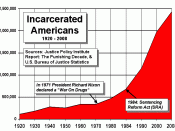Originally, the juvenile court was thought of as a social service organization that dealt with protecting and solving the problems of children in trouble. The primary role of the juvenile court was not to establish guilt but rather to rehabilitate youthful offenders by eliminating the problem causing the juvenile to engage in delinquent behavior. Emphasis was placed on rehabilitation, attention and education and these beliefs became the basis of what is known as the juvenile justice system. The juvenile justice system wants to keep citizens safe and rehabilitate delinquent youth and increase the competency of the juvenile offender and mold them into law abiding, tax paying citizens. Meeting these responsibilities has been the goal of the system since it was first implemented.
However, the juvenile justice system had a dramatic change in the early 1990s. Serious juvenile crimes were on the rise at an alarming rate. Youth arrests under the age of 18 for murder and negligent homicide increased 92.7%
(Bureau of Justice Statistics), from 1279 to 2465; robberies increased 12.1%, from 29892 to 33,510; aggravated assault increased by 71.7%, from 27,376 to 47,013. This led to a push for transforming the juvenile court to a criminal court. The past two decades have reversed the thought of rehabilitating juveniles to that of punishment for juvenile delinquents. The juvenile justice system applies criminal law to persons not old enough to be held responsible for criminal acts. The age for criminal culpability is usually 18. The goal of the juvenile justice system is still to rehabilitate, but if juveniles commit serious enough crimes they can be transferred into adult court if juvenile court waives or relinquishes jurisdiction.
The characteristics of the modern juvenile court have evolved over many decades. Legal reforms such as rulings of the U.S. Supreme Court (Kent v. United...



Nice
I enjoyed your essay and the format you used in delivering your information... Thank you.
0 out of 0 people found this comment useful.